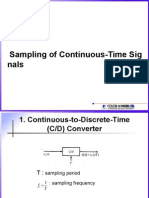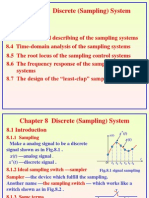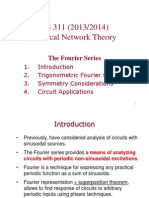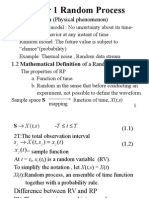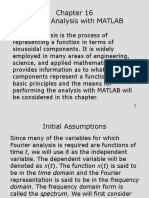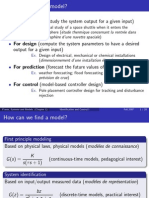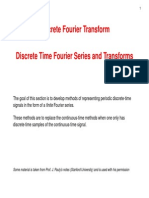Chapter 8 Discrete-Time Signals and Systems 8-1 Introduction
Chapter 8 Discrete-Time Signals and Systems 8-1 Introduction
Uploaded by
Anonymous WkbmWCa8MCopyright:
Available Formats
Chapter 8 Discrete-Time Signals and Systems 8-1 Introduction
Chapter 8 Discrete-Time Signals and Systems 8-1 Introduction
Uploaded by
Anonymous WkbmWCa8MOriginal Description:
Original Title
Copyright
Available Formats
Share this document
Did you find this document useful?
Is this content inappropriate?
Copyright:
Available Formats
Chapter 8 Discrete-Time Signals and Systems 8-1 Introduction
Chapter 8 Discrete-Time Signals and Systems 8-1 Introduction
Uploaded by
Anonymous WkbmWCa8MCopyright:
Available Formats
EE 422G Notes: Chapter 8
Instructor: Zhang
Chapter 8 Discrete-Time Signals and Systems
8-1 Introduction
Most real signals and natural (physical) processes: continuous
time
A : System Design Problem
How the computer sees the rest? an equivalent
(Physical Process + Sensor +A/D + D/A )=> discrete-time
system
Page 8-1
EE 422G Notes: Chapter 8
Instructor: Zhang
The Equivalent discrete-time system
Modeled by a discrete-time model
System Design (Design of the computer control Algorithm):
Based on discrete-time model description.
Needs for discrete-time system analysis and design
tool:
Z-Transform (Similar position as Laplace
Transform for continuous-time system.)
B. How does the computer understand the progress and behaviors of
the
process being monitored and controlled? By sampling the output
of the
continuous-time system!
=>
How can we ensure that the sampled signal is a sufficient
representation of
its continuous-time origin. i.e., how fast we have to sample?
based analysis!
A question we must answer before z-transform
C. Two basic parts of the chapter
Part one : Theoretical frame work for determining how fast we have
to sample.
Part two : z-transform
Part one: How fast
8.2A Analog-to-Digital Conversion
Page 8-2
EE 422G Notes: Chapter 8
Instructor: Zhang
1. Sample Operation
Needs to Know:
(1) Sampling period: T
t=nT
(2) x(t) is sampled at
(3) What do we mean
by x(n)
p(t)
(4) Sampling function:
(5) Sampled signal xs =
x(t)p(t)
Page 8-3
EE 422G Notes: Chapter 8
Instructor: Zhang
2. Mathematical Description of Sampling Process
Sampled signal : xs(t) = x(t)p(t)
Objective: Derivation of xs(t)s Fourier Series Expression (Time
Domain)
Derivation :
p (t )
General Equation for
any periodical signal
(thus can be expressed using Fourier
series), with
1
T
Sampling function: A Periodical
function,
fs
Fourier Series Desc
of Sampling Functio
jn 2 f s t
period T on fundamental frequency
With Fourier series coefficients:
1 T /2
Cn
p (t )e jn 2f s t dt
T T / 2
x s (t ) p (t ) x (t )
( C n e jn 2 f s t ) x ( t )
n
general equation for F
coefficient of any per
signal
general equation: always t
any r (width of the sampli
pulse).
x ( t ) e jn 2 f s t
3. Spectrum of sampled signal
Objective: Find the spectrum of the sampled signal xs(t).
Page 8-4
EE 422G Notes: Chapter 8
Instructor: Zhang
Derivation :
Take Fourier Transform for
x s (t )
C x (t ) e
jn 2f st
x (t )e
xs ( f )
j 2ft
dt
C x(t )e
n
C x(t )e
For n
j 2 ( f nf s ) t
dt
dt
jn 2f s t j 2ft
X ( f nf s )
X ( f nf s )
4. Spectral Characteristic of Real Signal
Most real signals: continuous with time
Highest frequency fh can be found
X(f) = 0 if | f | f h
5. How sampling process modifies the spectrum
Xs( f )
Consider a f 0 f h
Cn X ( f
nf s )
Page 8-5
EE 422G Notes: Chapter 8
Instructor: Zhang
X s ( f0 )
X ( f 0 nf s )
C 0 X ( f 0 ) [C1 X ( f 0 f s ) C 1 X ( f 0 f s )]
If
f0 fs fh
X ( f0 fs ) 0
X s ( f 0 ) C0 X ( f 0 )
or
or
f0 fs fh
X ( f0 fs ) 0
Modifier
Page 8-6
EE 422G Notes: Chapter 8
Instructor: Zhang
If
f0 fs fh
or
X ( f0 fs ) 0
f0 fs fh
or
X s ( f 0 ) C0 X ( f 0 )
modification
X ( f0 fs ) 0
No spectrum
6. How fast we have to sample in order to keep the spectrum:
Xs( f ) X( f )
(| f | f h )
| f f s | f h
| f f s | f h
Condition
Should we consider | f | f s ? Of course not!
( | f | f s implies that the real process
changes faster than the sampling rate.)
Consider | f | f s only =>
fs f fh
=>
fs f fh
fs f fh fs 2 fh
fs fh f fs 2 fh
Answer : f s 2 f h
process
Sampling rate: at least twice as the highest
frequency of the original
Sampling Theorem: .
Constant with n
Page 8-7
EE 422G Notes: Chapter 8
Instructor: Zhang
7. What about if r 0 ?
(show Figure 8-4)
1 T /2
1
jn 2f s t
p (t ) (t nT ) Cn
(
t
)
e
dt
fs
T
T
n
T / 2
1
X s ( f ) f s X ( f nf s ) X ( f nf s )
T n
n
8. Practical sampling rate:
f s 10 f h
Similar as r 0
8-2B Data Reconstruction
1. Whats Data Reconstruction?
Original x(t) t 0
(anytime)
Its samples xs(t) t = 0, T, 2T, (Discrete time)
Can we tell x(t) between sampled points ( nT < t < (n+1)T ) based
on xs(t)?
Data Reconstruction problem!
2. Data Reconstruction Method
Whats a filter? A system which processes the input to generate
an output.
It could be an algorithm (mathematical equation/operation
set) or
circuit/analog computer, depending on the form of xs(t)
(digital
number or analogy signal .)
Page 8-8
EE 422G Notes: Chapter 8
Instructor: Zhang
Lets see how a filter works!
Output
y (t )
xs (kT )h(t kT )
x(kT )h(t kT )
Discrete-tim
algorithm
y (kT ) x(kT ) h(0) [ x(kT T )h(T ) x(kT T )h(T )
[ x(kT 2T )h(2T ) x(kT 2T )h(2T )]
Weighted sum of the should be point
x(kT)
and its surrounding points
|h(0)| should > h() 0
and |h()| decreases as
What is y (t )
algorithm)
Lets see:
x(kT )h(t kT )
xs (t ) x(t )
xs (t )
? (In addition to being an
(t kT )
or
x(kT ) (t kT )
Consider xs(t)*h(t) :
a system with impulse response (s
parameter) h() and input xs(t)!
Page 8-9
EE 422G Notes: Chapter 8
Instructor: Zhang
xs (t ) * h(t )
x ( )h(t )d
s
x(kT ) ( kT )h(t )d
x(kT ) ( kT )h(t )d
x(kT )h(t kT )
The reconstruction algorithm
y (t )
x(kT )h(t kT )
Reconstruction Filter: with h(t) as impulse response!
Output of the reconstruction Filter (y(t)): Convolution of xs(t)
and h() !
3. Design of Reconstruction Filter: Ideal case
Assumption : fs>2fh
than the
1/2 fs > fh
(xs(t) was generated at a frequency higher
Nyquist rate).
fh: highest frequency of the original signal
Ideal Filter
T
H( f )
0
| f | 0.5 f s
Otherwise (| f | 0.5 f s )
Question : why do we need this low-pass filter to reconstruct x(t)
from xs(t)?
answer : xs(t) contains frequencies higher than f h 0.5 f s , but
x(t)does not!
Page 8-10
EE 422G Notes: Chapter 8
Instructor: Zhang
Question : Will any spectrum (other than x(t)s introduced by
sampling operation
remains after the filter?
Answer: No. f s 2 f h , has ensured that no overlapping between
x(t)s
frequencies and the undesired frequencies in xs(t)
introduced by
sampling!
Implementation of Ideal Reconstruction Filter
(Given the Impulse response of the filter)
Inverse Fourier transform =>
h(t )
H ( f )e
j 2ft
df
fs / 2
Te
j 2ft
fs / 2
df T
fs / 2
e j 2ft
j 2t
j 2ft
df
fs / 2
f fs / 2
f f s / 2
T sin(f s t ) T 1 / f s sin(f s t )
t
(f s t )
Characteristic of the Ideal Reconstruction Filter: Non causal!
Output at t ( y(t) ) must be generated using xs() > t
=> Not good for real-time application!
How to reconstruction x(t) from nT < t < nT + T ?
Answer :
t
sin f s ( k )
T
x(t ) y (t ) x(kT )
t
k n l 1
f s ( k )
T
nl
Page 8-11
EE 422G Notes: Chapter 8
Instructor: Zhang
for example t = nT + 0.5T
x(nT 0.5T ) y (nT 0.5T )
n l
k n l 1
l+1,,n)
(k=n+1,,n+l)
x(kT )
sin f s (nT 0.5 k )
f s (nT 0.5 k )
l points before t = nT + 0.5T
(k=n-
l points after t = nT + 0.5T
Page 8-12
EE 422G Notes: Chapter 8
Instructor: Zhang
Part Two
8-3A The z-Transform
1. Definition
For Laplace transform, we are given a function x(t),
For z-Transform, we are given a sampling sequence: x(0) , x(T),
x(2T),
Definition: z-transform of a given sequence x(0) , x(T), x(2T),
is
Z ( x(nT )) X ( z ) x(nT ) z n x(0) x(T ) z 1 x(2T ) z 2
n 0
Why do we define such a transform?
x(t)
L[ x(t )] x(t )e st dt
0
If we want to compute this Laplace transform by computer
L[ x(t )] x(nT )e snT T
n 0
T x(nT )(e sT ) n
On the other hand
n 0
Z [ x(nT )] x(nT ) z
z ~ e sT
n 0
x(nT): samples of
x(t)
L[ x(t )] TZ ( xs (t )) z esT
Relationship between z- and s-plane
Basic Relationship : z e sT
Page 8-13
EE 422G Notes: Chapter 8
Instructor: Zhang
z e ( j )T eT e jT
(1) 0
(eT 1) | z | 1 (note | e jT | 1)
l.h.p. (s- plane)
(2) 0
s: r.h.p.
(3) 0
inside the unit circle (z- plane)
s: j axis.
(4) s = 0 ( 0, 0 )
| z | 1
z: outside the unit circle
| z | 1
z: unit circle
e T 1
jT
e
cos T j sin T
z=1
Page 8-14
EE 422G Notes: Chapter 8
Instructor: Zhang
2. Basic z-Transform pairs
Example 8-4: z-transform of unit pulse (n) :
Solution :
1
x(nT )
0
n 0
( n)
n 0
1
X ( z ) x(0) x(T ) z 1
Note the difference bet
and (n)
bounded
unbo
Similar as Lapl
transform
Example 8-5 z-Transform of unit step sequence u(n):
Page 8-15
EE 422G Notes: Chapter 8
Instructor: Zhang
1
x(nT )
0
Solution :
n0
n0
X ( z ) x(0) x(T ) z 1
1 z 1 z 2
(| z 1 | 1
or
1
1 z 1
| z | 1)
How to understand?
L[u (t )]
Step function u(t) :
1
1
s
j
Does TX ( z ) z e sT give the same spectrum if T 0 ?
TX ( z ) z e sT
T
1 z 1
z e sT
T
1 e sT
T
1 e sT
s j
T
1 cos T j sin T
T 0 :
T
1
1
lim
T 0 sin T j cos T
1 cos T j sin T
j
z-Transform gives the same spectrum as Laplace
transform if the sampling rate
Example 8-6 : z-transform of unit exponential sequence
Page 8-16
EE 422G Notes: Chapter 8
Instructor: Zhang
x(nT ) e t |t nT e nT (e T ) n
( 0)
(k eT )
kn
Solution:
X ( z ) x(0) x(T ) z 1 x(2T ) z 2
1 kz 1 k 2 z 2
1 (k 1 z ) 1 (k 1 z ) 2
k 1 z
1 1 2
1
1
1
1
1 kz 1
1
X ( z)
1 e T z 1
k 1 z 1 1
T
z
k e
Is this result reasonable?
L[e
1 s j 1
]
s
j
s j
TX ( z ) | z e sT
T 0:
T
1 e ( j )T
1 e T e jT
1 e ( j )T
1
1
T 0 ( j )e ( j )T
j
lim
Why? Because
lim e ( j )T lim e T e jT
T 0
lim e
T 0
T 0
(cos T j sin T ) 1
1
0
Page 8-17
EE 422G Notes: Chapter 8
Instructor: Zhang
Example 8-6 B
x ( nT ) : k 0
k1 k 2
1
=> X ( z )
1 kz 1
Summary: Basic z-transform pairs
continuous Function
sequence
(t )
( n)
u (t )
u (n) : 1, 1,
e t
(e T ) n : 1, e t , e 2t ,
1, k , k 2 ,
(| z | k )
z - transform
1
1
1 z 1
1
1 e t z 1
1
1 kz 1
Would these be sufficient? No!
3. Extended z transform pairs
Page 8-18
EE 422G Notes: Chapter 8
Instructor: Zhang
4. Find z-transform using symbolic tool box
Example 8-7
Solution:
n
x ( nT ) a n cos
X ( z)
Analysis:
n
2
a n cos
n 0
(1) n : odd => cos(k
n
z
)0
Page 8-19
EE 422G Notes: Chapter 8
Instructor: Zhang
(2) n : even =>
n 2k cos(
1
n
) cos(k )
2
1
k : even
k : odd
n n
X ( z ) a n cos
z
2
n 0
a cosk z
2k
2 k
k 0
a0
a 4 z 4 a 8 z 8
a 2 z 2 a 6 z 6 a10 z 10
1 a 4 z 4
1 1 2 a 2 z 2 (1 a 4 z 4 a 8 z 8 )
1
a 2 z 2
1 1 1 1
1 a 2 z 2 1 a 2 z 2
1
1
4 4
1
1 a z
1 a 2 z 2
Very complex!
Using Symbolic ToolBox
syms a n z
xn = a^n*cos(n*pi/2);
xz = ztrans (xn, n, z);
xz (enter)
xz =
% Declare symbolic
% Define x(n)
% Determine X(z)
z^2/(a^2+z^2)
z2
1
a2 z2 1 a2 z 2
MatLab: always in terms of z instead of z-1.
8-3B Properties of z - transform
Page 8-20
EE 422G Notes: Chapter 8
Instructor: Zhang
1. Linearity
Z ( x1 (nT ) x2 (nT )) Z ( x1 (nT )) Z ( x2 (nT ))
X ( z)
2. Initial Value x (0) lim
z
why?
X ( z ) x(0) x(1) z 1
(1 z 1 ) X ( z )
3. Final value x() lim
z 1
Why?
But,
x() lim sX ( s )
s 0
s0
1
s
s
sX ( s )
lim sX ( s )
s 0
z 1
1
1 z 1
1 z 1
(1 z 1 ) X ( z )
lim(1 z 1 ) X ( z )
z 1
Page 8-21
EE 422G Notes: Chapter 8
Instructor: Zhang
8-3C Inverse z-Transform
Two Basic Methods:
(1) Express X(z) into Definition Form
X ( z ) x(0) x(1) z 1
(very simple, use long division or MatLab:
n=8
X = dimpulse(num,den, n) (enter)
gives the first n terms)
(2) Express X(z) into partial-fraction from
X (z )
partial-fraction
expansion
each term has an inverse transform
what Terms?
1
1
z 1
What about if you have
?
1 z 1
1 z 1
1
1
T 1
1 e z
1 kz 1
1
Tz 1
What
about
if
you
have
?
(1 z 1 ) 2
(1 z 1 ) 2
1
Te T z 1
What
about
if
you
have
?
(1 e T z 1 ) 2
(1 e T z 1 ) 2
Az 1
B
T 1 2
T 1 2
T 1
(1 e z )
(1 e z )
1 e z
1
Lets see:
Az 1 B Be T z 1
(1 e T z 1 ) 2
Page 8-22
EE 422G Notes: Chapter 8
Instructor: Zhang
transform of
Can we now find A and B? What is the inverse z1
(1 e
z 1 ) 2
What to do if you have
1
?
1 z 2
1
1
1 1
1
1 z 2
(1 jz 1 )(1 jz 1 ) 2 1 jz 1 1 jz 1
1
1
1
2 1 ( jz 1 ) 1 ( jz 1 )
(1) n / 2
1
1
1 n
n
n
n
x(nT ) Z (
) [( j) ( j) ] ( j) [(1) 1]
2
2
2
1 z
0
1
Important: before doing partial-fraction expansion, make sure
the z-transform is in proper rational function of z 1 !
Example 8.9
z2
X ( z)
( z 1)( z 0.2)
1
A
B
Solution : X ( z )
(1 z 1 )(1 0.2 z 1 ) 1 z 1 1 0.2 z 1
Heavisides Expansion Method:
X ( z)
A
B
1 z 1 1 0.2 z 1
Page 8-23
n eve
n odd
EE 422G Notes: Chapter 8
Instructor: Zhang
1
B (1 z 1 ) z 1
A
(1) (1 z ) X ( z )
1 0.2 z 1
1 0.2 z 1
1
1
B0
1
A
A
1.25
1 0 .2
1 0 .2
0 .8
1
(2) (1 0.2 z ) X ( z )
A(1 0.2 z 1 ) B (1 0.2 z 1 )
1 z 1
1 0.2 z 1
1
A(1 0.2 z 1 )
B
1 z 1
1 z 1
1 0.2 z 1 0 ( z 0.2 )
B 1 /(1 5) 1 / 4 0.25
X ( z)
1.25
0.25
x(nT ) 1.25 0.25(0.2) n
1
1
1 z
1 0 .2 z
Example 8-9B MatLab Method
(1) Find partial-fraction expansion
z2
1
X ( z) 2
1
z 1 .2 z 0 .2 1 1 .2 z 0 .2 z 2
b = 1;
a = [1 1.2 0.2];
[r, p, k] = residuez(b,a);
Page 8-24
EE 422G Notes: Chapter 8
Instructor: Zhang
r
1.25
r
0.25
1.0
p pole
0.2
1.25
0.25
1
1 1 .0 z
1 0.2 z 1
1.25
0.25
1
1 z
1 0.2 z 1
(2) Directly Find Inverse Transform
syms n, z;
% Declare symbolic
xz = 1/(1-1.2*z^(-1)+0.2*z^(-2));
% define X(z)
xn = iztrans(xz,z,n);
% compute x(n)
xn
xn = 5/4-(1/4)*(1/5)^n x(nT) = 1.25-0.25(0.2)n
Example 8-10
Y ( z)
Solution :
1
z 2 1.2 z 0.2
z2
z 2Y ( z ) (or
Question: Define X ( z ) 2
z 1.2 z 0.2
Y ( z ) z 2 X ( z ) )
any relationship between
x(nT ) z 1 ( X ( z )) and
y (nT ) z 1 (Y ( z )) ?
Page 8-25
EE 422G Notes: Chapter 8
Instructor: Zhang
Y ( z)
1
z 2
z 2
z 2 1.2 z 0.2 z 2 ( z 2 1.2 z 0.2) 1 1.2 z 1 0.2 z 2
5(1 1.2 z 1 0.2 z 2 ) 5(1 1.2 z 1 )
5 6 z 1
5
1 1.2 z 1 0.2 z 2
1 1.2 z 1 0.2 z 2
5 6 z 1
5 6 z 1
1 1.2 z 1 0.2 z 2 (1 z 1 )(1 0.2 z 1 )
A
B
1 z 1 1 0.2 z 1
V ( z)
A V ( z )(1 z 1 ) | z 1 1
5 6 z 1
1 0.2 z 1
z 1 1
5 6 z 1
B V ( z )(1 0.2 z ) | z 1 5
1 z 1
1
1.25
0.8
z 1 5
5 30
6.25
4
1
1
6
.
25
1 z 1
1 0.2 z 1
y (nT ) 5 (n) 1.25 6.25(0.2) n
Y ( z ) 5 V ( z ) 5 1.25
y (nT ) 5 (n) 1.25 6.25(0.2) n
x(nT ) 1.25 0.25(0.2) n
= 1.2
n=0
n=1
5 + 1.25 - 6.25 = 0
0 + 1.25 - 6.25*0.2 = 0
n=2
0 + 1.25 - 6.25*0.22 = 1
0.25*0.22 = 1.24
n=3
0 + 1.25 - 6.25*0.23 =1.2
0.25*0.23 = 1.248
1.25 - 0.25 = 1
1.25 - 0.25*0.2
1.25 1.25 -
Page 8-26
EE 422G Notes: Chapter 8
Instructor: Zhang
Why? 6.25*0.2*0.2=0.25
=>1.25 6.25(0.2) n 2 1.25 0.25(0.2) n
y(n+2) = x(n)!
delay
Does Y ( z ) z 2 X ( z )
always imply Z 1 (Y ( z )) has two-step-
than Z 1 ( X ( z )) ?
Yes!
z-1 : Delay operator! (Must Assume X(nT)(the sequence to be z^(-1)
processed)=0 for n<0)
8-3D Delay operator : z-k ( k steps ) ( k > 0 )
Z ( x(nT )) X ( z ) x(nT ) z n
n 0
Z ( x(nT kT )) x(nT kT ) z n
n 0
x(nT kT ) z
n k
n 0
x(nT kT ) z
( n k )
n 0
We want to establish the relationship between Z(x(nT-kT)) and
Z(x(nT)) !
Lets see whats
x(nT kT ) z ( nk ) :
n 0
(1)
x(nT kT ) z ( nk )
n k 0
(2)
x ( nT kT ) z
Z ( x( nT )) ? Yes!
( n k )
n0
Page 8-27
EE 422G Notes: Chapter 8
Instructor: Zhang
n k 1
kT
x ( nT
)z
n0
( n k )
n k
nT kT 0
x ( nT kT ) z
x ( nT kT ) z ( n k )
nk
( n k )
n k 0
Z ( x ( nT ))
Z ( x(nT kT )) z
x(nT kT )) z ( nk ) z k Z ( x(nT ))
n 0
x(nT kT )
Z ( x(nT kT ))
k steps
x(nT )
behind
z k
Z ( x(nT ))
z k Z ( x(nT ))
Question : If Z ( x(nT ))
z 2
1 0.5 z 1
1
, whats
1 0.5 z 1
Z ( x(nT 2T )) ? Answer:
8-4 Difference Equation and Discrete-Time Systems
Continuous-Time System: Differential Equation, Laplace
Transform
Discrete-Time System: Difference Equation, z-Transform
Properties of Continuous-Time Systems
Properties of Discrete-Time Systems
8-4A Properties of Discrete-Time Systems
Page 8-28
EE 422G Notes: Chapter 8
Instructor: Zhang
System : Processes input to generate output
How to process : system-dependent
General symbolic notation for Discrete-Time System:
y( nT ) = H [ x(nT) ]
what does this
notation tell us?
operator or
Processor
1. Shift-Invariant System
(Time-Invariant Systems for continuous-time or general)
An example of time-varying system
The processing algorithm which maps input to
output changes!
What do we mean by a time-invariant system?
Shift-invariant systems:
Physical:
Mathematic:
Assume x(nT): x(0), x(T), has generated
y(nT): y(0), y(T),
For example:
x:
generated
1 has
y : 0 .2 0 .4 0 .6 0 .8 1
If we apply x(nT n0T ) as input
look at if n0 2
Page 8-29
EE 422G Notes: Chapter 8
Instructor: Zhang
0 1
x(nT 2T )
x: 0 0
y (nT 2T )
y : 0 0 0 .2 0 .4 0 .6
generated
Question: Is this system shift-invariant?
Yes!
Question: Is this example telling us
H [ x(nT 2T )] y (nT 2T ) ? Yes!
Question: Is H [ x(nT 2T )] y (nT 2T )
or H [ x(nT n0T )] y (nT n0T )
always true for different
systems?
No! only for time-invariant systems!
Shift-invariant system: if H [ x(nT n0T )] y (nT n0T ) true for
any n0 .
2. Causal and noncausal systems
Physical Description: A system is causal or nonanticipatory if the
systems response to an input does not depend on future values of the
input.
Mathematical Description:
What about for n
Page 8-30
EE 422G Notes: Chapter 8
Instructor: Zhang
Causal system: x1 (nT ) x2 (nT )
for
H [ x1 (nT )] H [ x2 (nT )]
for
n n0
n n0
Why? Although x1(nT) may not be the same as x2(nT) for n > n0
, such difference does not affect the output determined by input
up to n = n0 .
3. Linear System
Linear System
H [1 x1 (nT ) 2 x2 (nT )] 1H [ x1 (nT )] 2 H [ x2 (nT )]
Linear Systems: can be modeled as
x(kT )h(nT kT )
y ( nT )
y ( nT )
or
h(kT ) x(nT kT )
Convolution
h(kT ) : response of the shift-invariant linear system at t=kT to
an impulse input applied at t=0. (Or the response at t kT k 0T to an
impulse input applied at t k 0T )
Causal systems: h(kT ) 0 k 0
Linear+causal+ x ( kT ) 0
y (nT )
( k 0)
x(kT )h(nT kT )
x ( kT ) 0 ( k 0 )
x(kT )h(nT kT )
k 0
causal n
(nT kT 0) nT kT
x(kT )h(nT kT ) h(kT ) x(nT kT )
k 0
k 0
Example: Given
x(0) = 1, x(T) = 2, x(2T) = 2, x(3T) = 1,
Page 8-31
EE 422G Notes: Chapter 8
Instructor: Zhang
h(0) = 3, h(T) = 2, h(2T) = 1, h(3T) = 0,
MatLab:
x = [1 2 2 1 1];
h = [3 2 1];
y = conv(x,h);
y
3
8
11
9
7
3
1
Example 8-13:
n
1
x ( nT ) u( n )
n
n
2
1
1
y ( nT ) x ( nT ) * h( nT ) 3 2
n
2
3
1
h( nT ) u( n )
3
Can you write a program (algorithm) to calculate y(nT) =
x(nT)*h(nT) ?
Example 8-13: Symbolic Tool Box
syms n z
xn =(1/2)^n
hn = (1/3)^n
xz = ztrans(xn, n, z)
hz = ztrans(hn, n, z)
yz = xz*hz
yn = iztrans (yz, z, n);
yn (enter)
yn = 3*(1/2)^n-2*(1/3)^n
% Declare Symbolic
% x(n)
% h(n)
% z-transform of x(n)
% z-transform of h(n)
% multiply, not convolution
% Do you know why?
% y(nT)=3(1/2)n 2(1/3)n
* Analytic solution of convolution
x ( nT )
x ( nT )
0
h( nT )
h( nT )
0
n0
X ( z ) Z ( x ( nT ))
n0
n0
H ( z ) Z ( h( nT ))
n0
Page 8-32
EE 422G Notes: Chapter 8
Instructor: Zhang
Z ( x(nT ) * h(nT ))
Z { x(kT )h(nT kT )}
k
{ x(kT )h(nT kT )} z n
n<kn-k<0
n 0 k
n 0
x(kT ) h(nT kT ) z
k 1
n
x(kT ) h(nT kT )z h(nT kT ) z n
k 0
k 0
nk
n 0
x ( kT ) 0
k 0
nk
x(kT ) h(nT kT ) z
x(kT )z k
k 0
h(nT kT ) z
n k
n k 0
X ( z)H ( z)
i.e.
x(nT ) * h(nT ) Z 1 [ X ( z ) H ( z )]
x(nT ) 0 h(nT ) 0
if
1
1
Example: x ( nT ) u ( n 3)
4
4
1
1
h( nT ) u( n 5)
3
3
Solution:
z(nk)
Find x(nT)*h(nT)
x ( nT ) 0
h( nT ) 0
n 0
n 0
1
4
1
3
n 3
n 5
n 0
u( n 3)
u( n 5)
u( n 3)
due to
u( n 5)
Page 8-33
EE 422G Notes: Chapter 8
Instructor: Zhang
3
n
1 3 3
1
1 1
X ( z ) z Z u (n) z
1
4 4
4
1 z 1
4
5
n 5
1 1
H ( z ) Z u (n 5)
3 3
5
n
1 5 1
z Z u (n)
3
3
1
1
z 5
1
3
1 z 1
3
1
X ( z)H ( z)
4
V ( z)
1
1
(1 z 1 )(1 z 1 )
4
3
1
1 8
z
1
1
3
(1 z 1 )(1 z 1 )
4
3
3
4
1
1
1 z 1 1 z 1
4
3
1
1
Z 1 (V ( z )) (4( ) n 3( ) n )u (n)
3
4
1
1
Z 1 ( z 8V ( z )) (4( ) n 8 3( ) n 8 )u (n 8)
3
4
1 1
1
1
x(nT ) * h(nT ) ( ) 3 ( ) 5 [4( ) n 8 3( ) n 8 )]u (n 8)
4 3
3
4
4. Stable system
Consider linear shift-invariant systems only.
Definition of BIBO stable:
Page 8-34
EE 422G Notes: Chapter 8
Instructor: Zhang
| y ( nT ) |
Derivation of Criterion
for all bounded x(nT).
x(kT )h(nT kT )
y ( nT )
x(kT) bounded => | x ( kT ) | M
y (nT )
| x(kT ) || h(nT kT ) |
M | h(nT kT ) |
| h(nT kT ) |
| h(kT ) |
Criterion:
| h(kT ) |
Limited number of terms
How to use this criterion: A
h: h(0), h(1), h(N), 0, 0,
h( k ) 0
k 0
(causal)
causal + Limited N => stable
Why!
y ( nT )
x(kT )h(nT kT )
for any fixed n in
for example,
y (nT ) , N n k 0 n k n N
n 100
100 k 90
N 10
Page 8-35
EE 422G Notes: Chapter 8
Instructor: Zhang
| y (100T ) ||
100
x(kT )h(100T kT ) |
k 90
100
M | h(100T kT ) |
k 90
N
M | h(kT ) | stable
k 0
In general
y (nT )
x(kT )h(nT kT )
x(kT )h(nT kT )
k n N
| y (nT ) | M
| h(nT kT ) |
k n N
N
M | h(nT ) |
k 0
Conclusion: limited terms of h => stable!
Example : y ( nT )
x(kT )h(nT kT )
k 0
What about y ( nT )
Limited Terms
stable?
x(kT )h(nT kT )
k n 100
How to use this criterion: B
If we know
Z(h(nT)) = H(z)
H ( z)
1
1 0.2 z 1 0.22 z 2
1
1 0.2 z
h(0) h(1)
h(2)
Page 8-36
EE 422G Notes: Chapter 8
Instructor: Zhang
| h(nT ) |
n 0
What about H ( z )
Why? |0.2| < 1 !
1
1 z 1 z 2
1
1 z
Not BIBO stable!
In general, deg(num) < deg(den)
H ( z)
(1 p1 z ) (1 p n z n )
1
| p j | 1
stable
(poles inside the unit circle!)
Example 8-14: h(nT ) [4(1 / 3) n 3(1 / 4) n ]u (n)
h(nT ) 0 n 0
Due to u (n)
Solution:
| h(nT ) | | h(nT ) |
n 0
| 4(1 / 3)
n 0
3(1 / 4) | 4(1 / 3) n 4
n
n 0
1
6
1 1/ 3
Stable
8-4B Difference Equations
1. Difference Equations
Problem: determine the output of the system at the present time :
t = nT
y(nT)
Page 8-37
EE 422G Notes: Chapter 8
Instructor: Zhang
What information to use:
(1) input: current input u(nT)
previous input u(kT) (k < n)
future input u(kT) (k > n)
causal system : no future input!
Previous input u ( n 1), u ( n 2), ..., u ( n )
We do not need all of them use u(n-1), , u(nm)
(2) output: previous output (its history): y(kT) (k < n) ? Yes.
future output y(kT) (k >n) ? No, no future output
previous outputs y ( n 1), y ( n 2), ..., y ( n )
We do not need all of them! y(n-1), . , y(n-r) would
be sufficient!
Mathematical Equation
y(nT) : depends on
u( n 1),, u( n m )
y ( n 1),..., y ( n r )
Difference
Equation
linear system
y (nT ) L0 x(nT ) L1 x(nT T ) ... Lm x(nT mT )
k1 y (nT T ) ... k r y (nT rT )
weights: Li , K i
Larger weight: more important in determining y(nT)
Would the weights be the same? No!
(r, m): systems order
different systems: different order and weights
(parameters)
2. z-transfer function
Page 8-38
EE 422G Notes: Chapter 8
Instructor: Zhang
Different Equation
y (nT ) k1 y (nT T ) ... k r y (nT rT )
L0 x(nT ) L1 x(nT T ) ... Lm x(nT mT )
z-transform =>
Y ( z ) k1 z 1Y ( z ) ... kr z rY ( z )
L0 X ( z ) L1 z 1 X ( z ) ... Lm z m X ( z )
Y ( z ) L0 L1 z 1 ... Lm z m
H ( z)
X ( z)
1 k1 z 1 ... k r z r
z-transfer function
Y(z) = H(z)X(z)
response h(nT) ?
Why H(z) is the z-transform of impulse
8-4C Steady-State Frequency Response of a Linear DiscreteTime System
x(t)s spectrum X ( s ) s j
X ( )
Y ( )
( X ( s ) L[ x (t )])
x(nT)s spectrum TX ( z ) z e sT TX ( z ) z e jT
s j
y(t)s spectrum Y ( s ) s j
(Y ( s ) L[ y (t )])
Page 8-39
EE 422G Notes: Chapter 8
Instructor: Zhang
y(nT)s spectrum TY ( z ) z e sT TY ( z ) z e jT
s j
Systems frequency response
Y ( ) TY ( z ) |z e jT Y ( z )
X ( ) TX ( z ) |z e jT
X ( z ) z e jT
What is Y(z)/X(z) ? H(z) = Y(z)/X(z)
System frequency response
Y ( ) / X ( ) H ( z ) |z e jT H ( e jT )
Page 8-40
EE 422G Notes: Chapter 8
Instructor: Zhang
Property of frequency response H ( e jT )
T: sampling period
s 2f s 2
1
: sampling frequency
T
e j ( k s )T e jT e jk sT
s T 2
e jT e jk 2 e jT (cos k 2 j sin k 2 ) e jT
H (e j ( k s )T ) H (e jT )
Frequency Response H: periodic function with period s
when the frequency increase by k s , the
systems frequency
response
does not change.
Example:
Input 1: 10 sin(5t )
T = 1 second
Input 2 : 10 sin(7t )
Generate the same output amplitude?
Normalized Frequency r / s
s : frequency period s 2
jT
j 2 / s
r / s
1
T 2 / s
T
e j 2r
Frequency Response in terms of r (argument)
H ( e j 2r )
Amplitude Response | H ( e j 2r ) | or
Phase Response H ( e j 2r ) or
| H ( e jT ) |
H ( e jT )
Page 8-41
EE 422G Notes: Chapter 8
Instructor: Zhang
Question: what are their physical meaning?
Example 8-15: y(nT) = x(nT) + x(nT-2T)
Y ( z ) X ( z ) z 2 X ( z )
Solution :
H ( z)
Y ( z)
1 z 2
X ( z)
H (e jT ) 1 z 2
z e jT
1 e j 2T
(e jT e jT )e jT
2 cos T e jT
H ( e j 2r ) 2 cos 2r e j 2r
| H ( e j 2r ) | 2 | cos 2r |
cos 2r 0
2r
H ( e j 2r )
cos 2r 0
2r
Page 8-42
EE 422G Notes: Chapter 8
Instructor: Zhang
Comment: z-transform: good for analysis
difference equation: computer program
Page 8-43
You might also like
- Canadian Tire Corp. - Supply Chain Best PracticesDocument7 pagesCanadian Tire Corp. - Supply Chain Best PracticesAnonymous WkbmWCa8MNo ratings yet
- Ec010403 Signals and Systems Questionbank PDFDocument16 pagesEc010403 Signals and Systems Questionbank PDFSriju RajanNo ratings yet
- Ee422 8Document33 pagesEe422 8RamaDinakaranNo ratings yet
- Time Signals: Chapter 4 Sampling of Conti-NuousDocument29 pagesTime Signals: Chapter 4 Sampling of Conti-NuousShah HussainNo ratings yet
- Ch7 FourierTransform Continuous-Time Signal AnalysisDocument43 pagesCh7 FourierTransform Continuous-Time Signal AnalysisNat RajNo ratings yet
- Sampling of Continuous-Time Sig NalsDocument85 pagesSampling of Continuous-Time Sig NalsfrmshibuNo ratings yet
- Fourier Transform (For Non-Periodic Signals)Document27 pagesFourier Transform (For Non-Periodic Signals)hamza abdo mohamoudNo ratings yet
- C-T To D-T Conversion Sampling of C-T SignalsDocument23 pagesC-T To D-T Conversion Sampling of C-T Signalshamza abdo mohamoud100% (1)
- Signal ProcessingDocument275 pagesSignal ProcessingBruno Martins100% (1)
- Eee2035F Exam Signals and Systems I: University of Cape Town Department of Electrical EngineeringDocument3 pagesEee2035F Exam Signals and Systems I: University of Cape Town Department of Electrical EngineeringRubia IftikharNo ratings yet
- ECE 414 Tutorial 1: Review: Random Process Fourier Transform OuetasoDocument16 pagesECE 414 Tutorial 1: Review: Random Process Fourier Transform OuetasosaiknaramNo ratings yet
- Time-Continous Stochastic Processes 0. Time Continous Stochastic ProcessesDocument10 pagesTime-Continous Stochastic Processes 0. Time Continous Stochastic ProcessesHuy DuNo ratings yet
- ELEC221 HW04 Winter2023-1Document16 pagesELEC221 HW04 Winter2023-1Isha ShuklaNo ratings yet
- EE 424 #1: Sampling and ReconstructionDocument30 pagesEE 424 #1: Sampling and ReconstructionArunShanNo ratings yet
- INTRODUCTIONDocument18 pagesINTRODUCTIONRaja MuraliprasadNo ratings yet
- Ss QuetionsDocument7 pagesSs QuetionsSalai Kishwar JahanNo ratings yet
- Problem Set No. 6: Sabancı University Faculty of Engineering and Natural Sciences Ens 211 - SignalsDocument6 pagesProblem Set No. 6: Sabancı University Faculty of Engineering and Natural Sciences Ens 211 - SignalsGarip KontNo ratings yet
- Fourier PropertiesDocument14 pagesFourier PropertiesmfchinNo ratings yet
- ELE 301: Signals and Systems: Prof. Paul CuffDocument28 pagesELE 301: Signals and Systems: Prof. Paul CuffcartamenesNo ratings yet
- Chapter 8 Discrete (Sampling) SystemDocument38 pagesChapter 8 Discrete (Sampling) Systemmcoto99No ratings yet
- Sampling and ReconstructionDocument40 pagesSampling and ReconstructionHuynh BachNo ratings yet
- Discrete-Time Fourier Analysis Discrete-Time Fourier AnalysisDocument37 pagesDiscrete-Time Fourier Analysis Discrete-Time Fourier AnalysisTrần Ngọc LâmNo ratings yet
- III. Fourier Series and Fourier TransformDocument20 pagesIII. Fourier Series and Fourier TransformEduard Cosmin UngureanuNo ratings yet
- Network Theory-Electrical and Electronics Engineering-The Fourier SeriesDocument16 pagesNetwork Theory-Electrical and Electronics Engineering-The Fourier SeriesMompati Letsweletse100% (1)
- 2.signal and Linear System AnalysisDocument42 pages2.signal and Linear System Analysis390f.lkajfiNo ratings yet
- Chapter 1 Random Process: 1.1 Introduction (Physical Phenomenon)Document61 pagesChapter 1 Random Process: 1.1 Introduction (Physical Phenomenon)fouzia_qNo ratings yet
- Ece2610 Chap9Document24 pagesEce2610 Chap9Bayar JargalNo ratings yet
- Ch2 Fundamentals 2013Document16 pagesCh2 Fundamentals 2013Mark MaoNo ratings yet
- The Convolution Integral: D T H X T H T X T yDocument39 pagesThe Convolution Integral: D T H X T H T X T yshahriaraustNo ratings yet
- Chapter 3: Linear Time-Invariant Systems 3.1 MotivationDocument23 pagesChapter 3: Linear Time-Invariant Systems 3.1 Motivationsanjayb1976gmailcomNo ratings yet
- 06.sed - Sas.sys Resp CTDocument32 pages06.sed - Sas.sys Resp CTShahir AliliNo ratings yet
- Lecture 04 - Signal Space Approach and Gram Schmidt ProcedureDocument20 pagesLecture 04 - Signal Space Approach and Gram Schmidt ProcedureKhoa PhamNo ratings yet
- Tutorial On Control Theory: Stefan Simrock, ITERDocument95 pagesTutorial On Control Theory: Stefan Simrock, ITERAleksandar KošaracNo ratings yet
- 21modulation v110Document70 pages21modulation v110Abdullah Ashraf ElkordyNo ratings yet
- Objectives:: The Sampling TheoremDocument13 pagesObjectives:: The Sampling TheoremSalmaanCadeXaajiNo ratings yet
- Chapter 3Document62 pagesChapter 3Gwisani Vums Mav100% (1)
- Chapter 16Document37 pagesChapter 16LiNo ratings yet
- For Simulation (Study The System Output For A Given Input)Document28 pagesFor Simulation (Study The System Output For A Given Input)productforeverNo ratings yet
- Linear Systems: Prof. Dr. João Edgar Chaves Filho Mestrado em Eng. ElétricaDocument49 pagesLinear Systems: Prof. Dr. João Edgar Chaves Filho Mestrado em Eng. ElétricaAndré AraújoNo ratings yet
- Motivation For Fourier SeriesDocument18 pagesMotivation For Fourier Serieshamza abdo mohamoudNo ratings yet
- Digital Signal Processing (DSP) - Jeppiar CollegeDocument22 pagesDigital Signal Processing (DSP) - Jeppiar CollegeKarthi KeyanNo ratings yet
- Process ConvolutionDocument72 pagesProcess ConvolutionayadmanNo ratings yet
- 218 - EC8352, EC6303 Signals and Systems - 2 Marks With Answers 2Document26 pages218 - EC8352, EC6303 Signals and Systems - 2 Marks With Answers 2anakn803No ratings yet
- The Discrete-Time Fourier Transform: 44 MinutesDocument9 pagesThe Discrete-Time Fourier Transform: 44 Minutesapi-127299018No ratings yet
- Massachusetts Institute of Technology: Your Full Name: Recitation TimeDocument8 pagesMassachusetts Institute of Technology: Your Full Name: Recitation TimeThắng PyNo ratings yet
- Ece 3084 Su 14 HW 04Document5 pagesEce 3084 Su 14 HW 04Jay Mehta0% (1)
- FT PropertiesDocument15 pagesFT PropertiesahmdNo ratings yet
- Automatic ControlDocument16 pagesAutomatic ControlSayed NagyNo ratings yet
- CT ConvolutionDocument20 pagesCT ConvolutionahmdNo ratings yet
- Assingment 4Document5 pagesAssingment 4Rahul SreeNo ratings yet
- It 2cos (2) ) TRT) ,: E-Stu (T)Document1 pageIt 2cos (2) ) TRT) ,: E-Stu (T)Naeem GulNo ratings yet
- 2024 ELEC3004 Problem Set 1Document4 pages2024 ELEC3004 Problem Set 1songpengyuan123No ratings yet
- All Ss 5 - AssignDocument30 pagesAll Ss 5 - AssignBruce ArnoldNo ratings yet
- Mechanical Vibration 13Document0 pagesMechanical Vibration 13javed alamNo ratings yet
- (PPT) DFT DTFS and Transforms (Stanford)Document13 pages(PPT) DFT DTFS and Transforms (Stanford)Wesley George100% (1)
- Clase 02 Modelado de Sistemas de Control PDFDocument40 pagesClase 02 Modelado de Sistemas de Control PDFmiscaelNo ratings yet
- 1 Objectives: (Week-7: Fourier Transform: MATLAB) (LNMIIT, Jaipur)Document2 pages1 Objectives: (Week-7: Fourier Transform: MATLAB) (LNMIIT, Jaipur)DharmendraDixitNo ratings yet
- Continuous-Time Systems: Dept. of Electrical and Computer Engineering The University of Texas at AustinDocument24 pagesContinuous-Time Systems: Dept. of Electrical and Computer Engineering The University of Texas at AustinIr Wn IkaarinaNo ratings yet
- Unit-IV-Pulse Modulation & Digital Modulation Modulation: StaffDocument15 pagesUnit-IV-Pulse Modulation & Digital Modulation Modulation: StaffGokul SaharNo ratings yet
- Green's Function Estimates for Lattice Schrödinger Operators and ApplicationsFrom EverandGreen's Function Estimates for Lattice Schrödinger Operators and ApplicationsNo ratings yet
- TutorialDocument4 pagesTutorialAnonymous WkbmWCa8MNo ratings yet
- Elect: AFIT/GAE/ENY/9 ID-18Document114 pagesElect: AFIT/GAE/ENY/9 ID-18Anonymous WkbmWCa8MNo ratings yet
- Lec8h2 OptimalControl PDFDocument83 pagesLec8h2 OptimalControl PDFAnonymous WkbmWCa8MNo ratings yet
- Elect: AFIT/GAE/ENY/9 ID-18Document114 pagesElect: AFIT/GAE/ENY/9 ID-18Anonymous WkbmWCa8MNo ratings yet
- Optimal PID-Control On First Order Plus Time Delay Systems & Verification of The SIMC RulesDocument6 pagesOptimal PID-Control On First Order Plus Time Delay Systems & Verification of The SIMC RulesAnonymous WkbmWCa8MNo ratings yet
- Deadtime Modeling For First Order Plus Dead Time Process in A Process IndustryDocument3 pagesDeadtime Modeling For First Order Plus Dead Time Process in A Process IndustryAnonymous WkbmWCa8MNo ratings yet
- ! Maximini2004Document6 pages! Maximini2004Anonymous WkbmWCa8MNo ratings yet
- Nguyen 2011Document11 pagesNguyen 2011Anonymous WkbmWCa8MNo ratings yet
- Ventili Kao Aktuatori: OS4UIP 2013Document14 pagesVentili Kao Aktuatori: OS4UIP 2013Anonymous WkbmWCa8MNo ratings yet
- Hu2013 PDFDocument15 pagesHu2013 PDFAnonymous WkbmWCa8MNo ratings yet
- PID Tuning With Exact Gain and Phase Margins: Qing-Guo Wang, Ho-Wang Fung, Yu ZhangDocument7 pagesPID Tuning With Exact Gain and Phase Margins: Qing-Guo Wang, Ho-Wang Fung, Yu ZhangAnonymous WkbmWCa8MNo ratings yet
- Frequency Response Based PID Controller Design With Set Point FilterDocument4 pagesFrequency Response Based PID Controller Design With Set Point FilterAnonymous WkbmWCa8MNo ratings yet
- Cu Rad AcaDocument9 pagesCu Rad AcaAnonymous WkbmWCa8MNo ratings yet
- Ho1999 PDFDocument7 pagesHo1999 PDFAnonymous WkbmWCa8MNo ratings yet
- Three-Dimensional Visualization of Nichols, Hall, and Robust-Performance DiagramsDocument6 pagesThree-Dimensional Visualization of Nichols, Hall, and Robust-Performance DiagramsAnonymous WkbmWCa8MNo ratings yet





